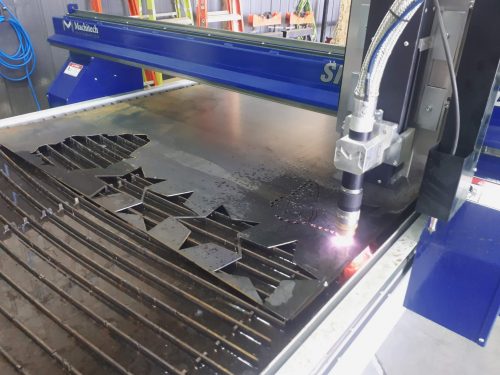Metal stamping and precision sheet metal fabrication are two common ways that metal components can be made to serve a wide variety of purposes, ranging from business signs and food processing equipment to architectural ornaments and structural supports. Let’s compare these two processes and learn the pros and cons of each.
Metal Stamping
Metal stamping entails shaping metal sheet into a desired shape using a press. There are many processes that accomplish this task, including bending, blanking, punching, coining, and flanging. Sometimes only one of these metal stamping processes is needed to make the shape. For more complex projects, one or more types of metal stamping may be used.
Pros of Metal Stamping
Metal stamping is a cost-effective solution for mid-to-high volume production. It offers more efficient processing of large quantities and intricately designed shapes. Additionally, it is a process that can be automated to speed up production and reduce scrap waste.
Cons of Metal Stamping
The biggest downside of metal stamping is its lengthy setup time. In fact, metal stamping requires specific tooling to be developed, which can slow pre-production. This also makes it difficult to change the design once the tooling is produced. Due to the longer setup time, short production of metal stamping tends to have a higher price-per-piece cost, which is why it is better suited for mid-to-high level volumes.
Precision Sheet Metal Fabrication
Flat sheets of steel, aluminum, and other alloys can be processed using a plasma cutter or another type of custom fabrication technology. Like stamping, there are many sub-processes involved with fabricating metal sheet, including cutting, welding, forming, and bending. The capabilities of precision sheet metal fabrication are virtually endless, but this process is particularly suitable for manufacturing functional parts like brackets, panels, and enclosures.
Pros of Sheet Metal Fabrication
Fabricating sheet metal on a plasma cutting table or similar equipment offers far greater flexibility and versatility in manufacturing custom components. Unlike stamping, sheet metal fabrication has a short startup time and therefore is much more efficient (and economical) at smaller size production runs. Plasma cutters can come equipped with CNC operations to automate the fabrication process and eliminate cutting mistakes.
Cons of Sheet Metal Fabrication
Burn tables are typically labor intensive, though this drawback can also be alleviated with CNC controls, which often reduce the number of technicians needed to operate them to one. Another con is that there are limitations to how much detail can go into the shape—if the design is intricate, metal stamping will produce a better result.
CNC Plasma Cutting Tables and Other Heavy-Duty Solutions for Custom Fabrication
Machitech is the premier manufacturer of CNC plasma cutting machines and other custom fabrication solutions. Our state-of-the-art equipment is customizable to meet any production need and includes free and unlimited lifetime support. Contact Machitech today to learn more.
 English
English  Français
Français 
